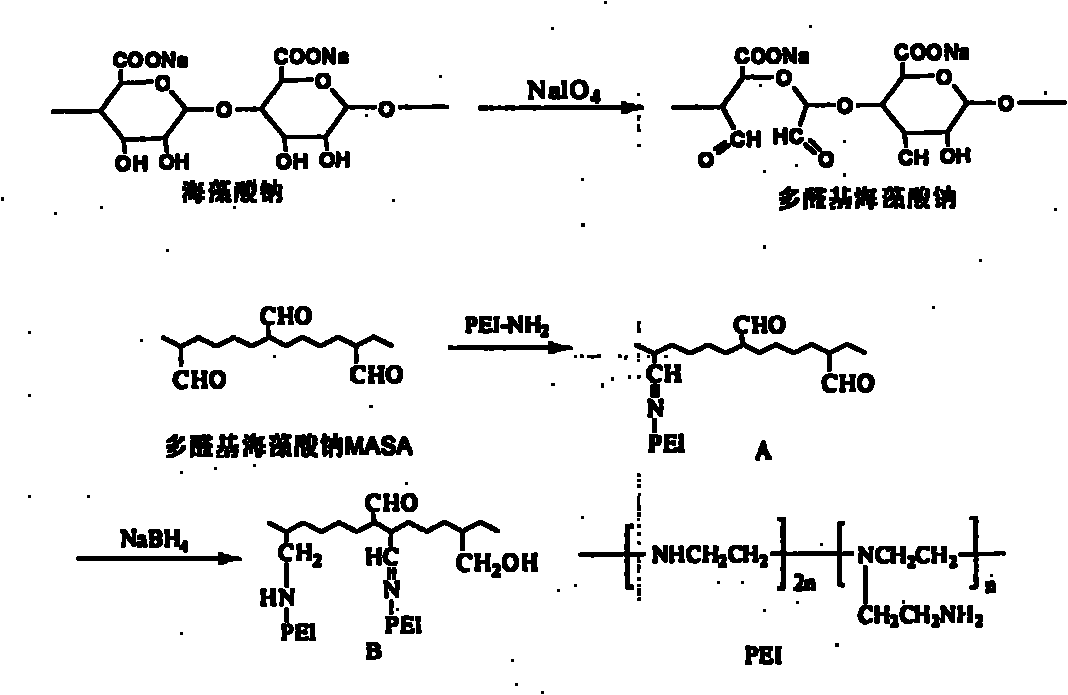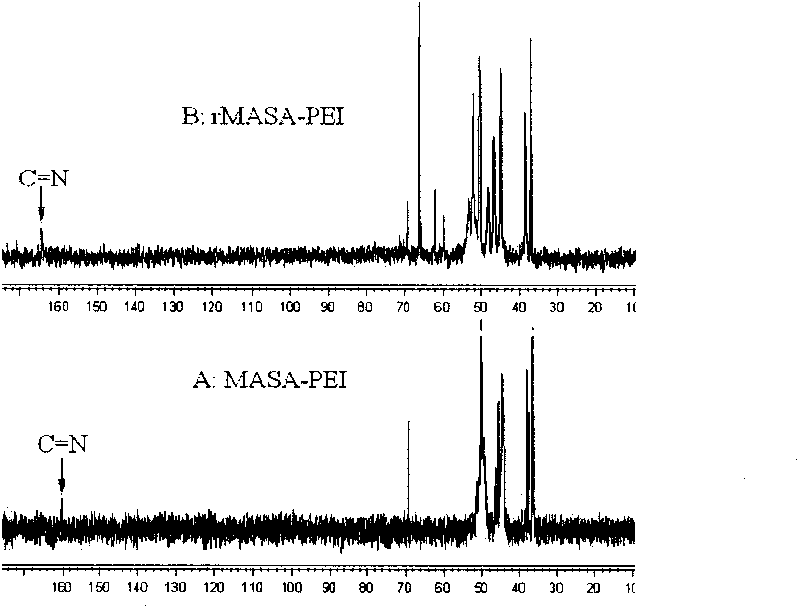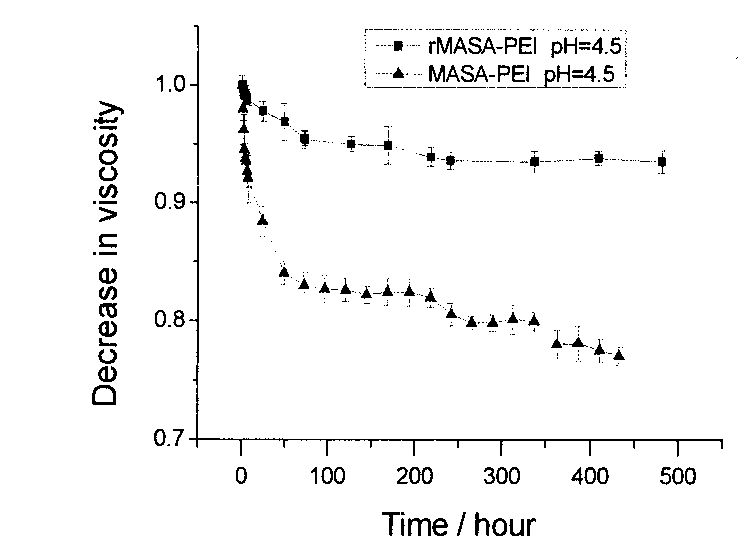Cationic polymer gene vector having low cytotoxicity and high transfection efficiency, preparation method and use thereof
A cationic polymer and gene carrier technology, applied in the field of biomedicine, can solve the problems of high gene transfection efficiency, cytotoxicity, and low transfection efficiency, and achieve the goal of improving gene transfection efficiency, high transfection efficiency, and reducing cytotoxicity Effect
- Summary
- Abstract
- Description
- Claims
- Application Information
AI Technical Summary
Problems solved by technology
Method used
Image
Examples
Embodiment 1
[0042] 1.1 Synthesis of polyethyleneimine-polyaldehyde sodium alginate graft copolymer MASA-PEI
[0043] According to the applicant's patent method (see ZL 200610036842.8) to synthesize polyaldehyde sodium alginate MASA. Take polyaldehyde sodium alginate 0.5g (containing aldehyde group 1.46×10 -3 mol, the degree of oxidation is 0.29, M η =33K), dissolved in 10ml of water to obtain solution 1. 5.27g polyethyleneimine PEI 1.8k (2.92×10 -3 mol, n 醛基 / n PEI 1.8k =1 / 2, n represents the amount of substance, and the unit is mole) is dissolved in 30ml water, adjusts pH to 8 with 3M hydrochloric acid, adjusts solution total volume to 55ml with distilled water, and this is solution 2. The solution 1 was slowly dropped into the solution 2 under stirring, and the drop was completed within 1 hour. After dropping, the reaction was stirred at room temperature for 24 h. The reaction product was dialyzed in distilled water for 72h, the insoluble matter was filtered off, and MASA-PEI wa...
Embodiment 2
[0047] 1.1 Synthesis of polyethyleneimine-polyaldehyde sodium alginate graft copolymer MASA-PEI
[0048] According to the applicant's patent method (see ZL 200610036842.8) to synthesize polyaldehyde sodium alginate MASA. Take polyaldehyde sodium alginate 0.5g (containing aldehyde group 1.46×10 -3 mol, the degree of oxidation is 0.29, M η =33K), dissolved in 10ml of water to obtain solution 1. 1.24g PEI 423 (2.92×10 -3 mol, n 醛基 / n PEI0423k =1 / 2, n represents the amount of substance, and the unit is mole) is dissolved in 30ml water, adjusts pH to 8 with the sulfuric acid of 3M, adjusts solution total volume to 55ml with distilled water, and this is solution 2. The solution 1 was slowly dropped into the solution 2 under stirring, and the drop was completed within 1 hour. After dropping, the reaction was stirred at room temperature for 36 h. The reaction product was dialyzed in distilled water for 72h, the insoluble matter was filtered off, and MASA-PEI was obtained after...
Embodiment 3
[0052] 1.1 Synthesis of polyethyleneimine-polyaldehyde sodium alginate graft copolymer MASA-PEI
[0053] According to the applicant's patent method (see ZL200610036842.8), polyaldehyde sodium alginate MASA was synthesized. Take polyaldehyde sodium alginate 0.5g (containing aldehyde group 1.92×10 -3 mol, the degree of oxidation is 0.38, M η =24K), dissolved in 10ml of water to obtain solution 1. 6.91g PEI 1.8k (3.84×10 -3 mol, n 醛基 / n PEI1.8k =1 / 2, n represents the amount of substance, and the unit is mole) is dissolved in 30ml water, adjusts pH to 7 with 2M hydrochloric acid, adjusts solution total volume to 55ml with distilled water, and this is solution 2. The solution 1 was slowly dropped into the solution 2 under stirring, and the drop was completed within 1 hour. After dropping, the reaction was stirred at room temperature for 36 h. The reaction product was dialyzed in distilled water for 60 h, the insoluble matter was filtered off, and MASA-PEI was obtained after...
PUM
 Login to View More
Login to View More Abstract
Description
Claims
Application Information
 Login to View More
Login to View More - R&D
- Intellectual Property
- Life Sciences
- Materials
- Tech Scout
- Unparalleled Data Quality
- Higher Quality Content
- 60% Fewer Hallucinations
Browse by: Latest US Patents, China's latest patents, Technical Efficacy Thesaurus, Application Domain, Technology Topic, Popular Technical Reports.
© 2025 PatSnap. All rights reserved.Legal|Privacy policy|Modern Slavery Act Transparency Statement|Sitemap|About US| Contact US: help@patsnap.com



